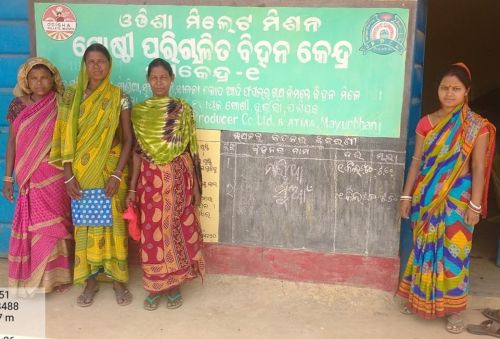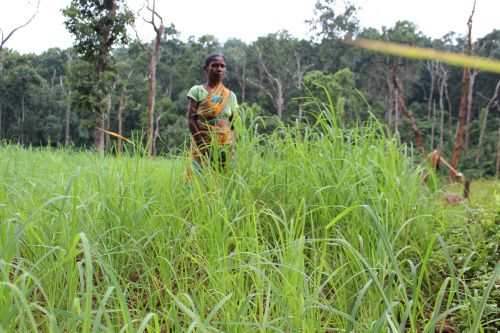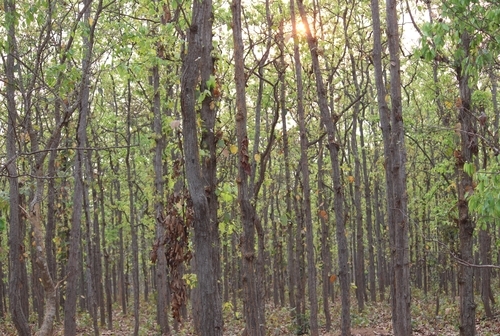Similipal in Odisha's Mayurbhanj district is one of the 18 biosphere reserves in the country. It is home to 1078 species of plants, including 93 species of orchids and 300 species of medicinal plants. The area is spread over 2750 square km and blessed with numerous crests, valleys, waterfalls and perennial streams. There are 1265 villages at the edges of the forests, with a total population of around 4 lakh. Nearly three-fourths of the people here are Scheduled Tribes - Kolha, Santal, Bhumija, Bhatudi, Gond and Ho, as well as some particularly vulnerable tribal groups such as Mankidia, Lodha and Hill Kharia.
Most tribal communities living around the periphery of SBR depend on rainfed agriculture and minor forest produce. Some of the local varieties of paddy includes Dhobobhojonal, Balibhojona, Bobemundi and Pimpudibas. Similarly, Dhobli and Jhuta arhar varieties, Nipania mustard variety and several varieties of millets are grown by the farmers. These traditional varieties of crops are highly nutritious and have distinct taste and aroma; they can also be preserved for long periods. These are hardy crops grown over generations, and are resilient to weather changes, diseases and pest infestation.
Over the years, promotion of mono-cropping and extensive use of chemical inputs has degraded the fertility of soil and affected the biodiversity in the area. Farming has become largely unremunerative for the farmers. Many farmers now prefer to work in brick kilns, and some work as daily wage labourers to earn a living in other states. The penetration of high yielding and genetically modified seeds has threatened conservation of traditional varieties of landraces. Unsustainable agricultural practices have not only weakened the tribal economy but also aggravated food and nutrition insecurity among the people. This has resulted in critical poverty and vulnerability for tribal and forest dwelling communities.
Odisha Millets Mission
In 2017, Odisha's Department of Agriculture and Farmers Empowerment (DA&FE) launched a five-year programme known as Odisha Millets Mission (OMM) in tribal areas to revive millets in farms and on plate. Considering its phenomenal success, the state government has extended OMM to 142 blocks in fiscal year 2022, with a target of reaching out to more than 75,000 hectares (Ha) and around 1.5 lakh farmers.
 Finger millet being cut at Anlajodi in Bangriposi block.
Finger millet being cut at Anlajodi in Bangriposi block.
Credit: Odisha Millets Mission.
The department, in collaboration with local civil society organisations such as Centre for Regional Education, Forest and Tourism Development Agency (CREFTDA - www.creftda.org) and Gram Swaraj, has been working in Mayurbhanj's Jashipur, Bisoi and Bangiriposi blocks. Technical and programme support under OMM is provided by Agriculture Technology Management Agency (ATMA) at the district level and Watershed Support Services and activities network (WAASAN) at the state level, respectively. Farmers have been encouraged to cultivate millets through harmonizing traditional agro-ecological wisdom with improved agronomic practices.
Why millets?
Tribal farmers in and around SBR traditionally grew millets that are suited to local climate and terrain. Millet grows easily in minimal water, is resilient to pests, and some varieties have shorter harvesting periods. Finger and little millets can be stored for many years unlike wheat and rice. "Millets support resilience building and adaptation, and enhance livelihoods for small-scale farmers, including women," says Bishow Parajuli, Representative and Country Director in India, World Food Programme, in a study of OMM by the organisation.
The most important benefit is nutrition. Millet is a starchy, gluten-free grain that is packed with vitamins and minerals like calcium, phosphorous and magnesium. A number of researchers have documented the role played by these nutrients in bone health, nerve and muscle function.
Diverse traditional foods in diets are key to good indicators of food and nutritional security, but tribal communities in the area are losing these steadily. Officials in the state government as well as local farmers say that over the years, cultivation of millets in the SBR area has declined quite a bit. And the consequences for health and nutrition have been stark. The fourth National Family Health Survey, 2015-16 found that children under five years of age in Mayurbhanj were stunted for their age, and 43.8 per cent of them were under-weight - nearly 10 per cent higher than the state average.
Addressing seed insufficiency
As millet cultivation has declined, many farmers have lost their traditional seeds, which are crucial to increase crop yields. Quality seed ultimately increases the efficiency of crop multiplication. To ensure easy access and availability of quality seeds for the farmers, 12 community managed seed centres (CMSCs) were established at the block level in Mayurbhanj. These CMSCs are managed by registered Farmer Producer Organisations (FPOs).
Training programmes are organised for FPOs and women self-help groups (WSHGs) on the process of preserving quality seeds through using bins, tarpaulin sheets, weighing machines and moisture meters. FPOs have been supported with working capital for acquiring seeds and for overseeing the operational costs for managing CMSCs. For instance, Jashipur FPO is managing a CMSC at Jashipur block. Under its CMSC, there are three sub-centre CMSCs operating at the panchayat level at Tangabila, Katira and Durdura. These sub-centre CMSCs are managed by WSHGs. Farmers often collect seeds from these CMSCs.
 Community managed seed centre in Jashipur.
Community managed seed centre in Jashipur.
Credit: Odisha Millets Mission.
Ashirta Hembram is a tribal farmer from Kukurbhuka village in Astakunwar panchayat in Jashipur block. He said, "We are happy to find seed centres in our area. Even if we don't have money, we can get seeds from these centres. If we take 1 kg of seeds from the seed centre, then we return 2 kg of seeds after harvesting our crop." Some farmers are also buying seeds from CMSCs where one kg of finger millet seed is sold at Rs.40. Jaishree Mohanto, the Chief Executive Officer of Jashipur FPO says, "Farmers are getting good prices for their crops. Our CMSCs are ensuring that high quality seeds are available for farmers at right time and place at affordable rate. As a result, this has strengthened seed production facilities in the SBR area."
Pankaj Singh, Managing Director of Jashipur FPO outlined, "CMSCs are facilitating identification of suitable seed varieties for the SBR's agro-climatic conditions. This is accelerating the seed replacement rate and promoting fast adoption of promising traditional and improved seed varieties. In the long run, it will support the horizontal and vertical expansion of the agro-ecological system for sustainable livelihood security."
"The impact of the seed preservation and exchange initiative under OMM is apparently visible," said Nabakishore Sethy, Block Agriculture Officer in Jashipur. It has not only increased cropping intensity and boosted crop productivity, but also promoted socio-economic development and strengthened seed infrastructure in remote areas. The government must further scale up this promising initiative across the district, he urged.
Seed multiplication, documentation and evaluation
In the Millets Mission, there is great emphasis on multiplication of benefits by selecting, purifying and promoting the best local varieties. Some farmers are designated by the mission as 'Seed Farmers', and they play leading roles in conservation and exchange among farmers in their respective regions. In Bangiriposi, Bisoi and Jashipur blocks, 52 farmers were trained on finger millet seed multiplication during 2020-21. Some of the varieties of seeds used for multiplications include Arengu, Bhairabi, Chaitanya, etc. The seed multiplication plot is treated with organic inputs such as ghanajeevamrua, jeevamaruta and handikhata.
To ascertain the productivity of selected seed varieties, participatory varietal trials were conducted in collaboration with farmers. Seed varieties were selected based on their suitability to local conditions, while maintaining proper documentation of seed characteristics, yield rate, nutrition value and its resilience to diseases and pest infestation.
Seed varieties are characterized and evaluated based on the farmers requirements, which are quite wide-ranging. Some of the criteria include palatability and cooking time, ability to compete with weeds, adaptability to the environment, crop-duration, pest and infestation resistance, height of the plants, tillering potential, grain and fodder yields, storage quality of seeds, and special cultural values and use in ceremonies.
"We maintain a comprehensive database of every [farm and] farmer. It contains information about the crop at every stage, type and quantity of inputs used, pest control techniques used, characteristics of crop, yield obtained, and post-harvest management techniques," explained Aswini Kumar Das, Mayurbhanj District Project Coordinator at Watershed Support Services and Activities Network (WASSAN - www.wassan.org).
Setting up bio-input centres
To reduce the use of chemical fertilizers and pesticides and minimize input cost, bio-input centres have been established at the panchayat level. Locally available resources such as cow dung and urine, karanja leaves (Pongamia pinnata), arakha leaves (Calotropis gigantea), neem leaves (Azadirachta indica) and jaggery are used to produce bio-inputs including jeevaamruta, handikhata, nimastra, agniastra and bijamruta.
These bio-input centres are promoted through FPOs and WSHGs. They undertake community outreach programmes to sensitize the multiple benefits of applying bio-inputs in farm to boost production and protect crop from pests and diseases. Ma Hingula WSHG with support and technical guidance of Jashipur FPO has established a bio-input unit in the year 2020. The WSHG managed to prepare and sell 3,406 liters of jibamruta, 60 liters of handikhata and 40 liters of nimastra, making a profit of Rs.15,614. "We are very excited. There is huge demand for bio-inputs in our area. We are going to scale up our unit. And increase the volume of production," said Manjula Sethi, President of Ma Hingula WSHG.
 Members of Maa Hingula WSHG with their bio-inputs.
Members of Maa Hingula WSHG with their bio-inputs.
Credit: Odisha Millets Mission.
Farmers are happy with the results from bio-inputs. Muni Kalundia from Saruda village in Astakunwar panchayat is one such farmer. She said, "All inputs we use are organic. The seeds, manure, pesticide, insecticides, are all produced organically. And their timely application is enhancing germination and crop yield, preventing insects and pests. It has reduced our expenses ten-time less in comparison to inorganic farming."
System of Millets Intensification
Traditionally in this region, land was ploughed and seeds were directly broad-casted by farmers. The production under this method ranges between 5 to 7 quintals per hectare. When seeds are broad-casted, getting high yields from small pieces of land is difficult, as the germination is not uniform. Therefore, to improve the productivity of millets, OMM has promoted the System of Millets Intensification (SMI) among the farmers. SMI is a package of practices for millet cultivation that reduces utilisation of resources and increases the potential for higher yields.
Sarita Hansda is a successful tribal woman farmer in Gopinathpur village in Jashipur. In her words, "In the past, we used to sow 5 kg of seed per acre. Now, in the SMI method, we only use around 500-gram seed. Earlier, some seeds used to sprout, while some never did. After we received training on SMI from CREFTDA, now we are planting saplings after growing them in nurseries. Before planting finger millet, the farmland is cultivated and fertilized with farmyard manures. In this way, plants get adequate light, nutrients and space to grow. As a result, we are harvesting a bounty of crops each year."
"These improved agronomic practices have increased finger millet crop yields and coverage area, and ensured profitability of millet cultivation for the farmers," said Pulak Ranjan Nayak, seed researcher at WASSAN. It has substantially improved the soil quality with efficient use of water, thereby promoting better crops and an eco-friendly cropping system, he added.
Promoting intercropping and mixed cropping systems
Major emphasis has been laid on promoting inter-cropping of finger millets with pulses. There are several benefits of this - nutritional security, resource conservation, production and productivity enhancement and soil health management. Farmers were encouraged to grow finger millets with black gram. The transplanting of finger millet is done with a row-to-row and plant-to-plant space of 20x10 centimeters. And 15 days after transplanting, de-weeding is done by cycle weeder. The inter-cropping between finger millets and black gram is done at the ratio of 6:1, that is after every 6 lines of finger millets one line of back gram is sown.
Similarly, farmers have inter-cropped sorghum with rice bean and black gram. Sorghum is transplanted with a row-to-row and plant-to-plant space of 45x15 centimeters. After the first de-weeding, black gram or rice bean is sown in between two rows of sorghum. The row-to-row and plant-to-plant spacing of black gram/rice beans is 10 centimeters. Some farmers have intercropped finger millets with white lobia beans. In this model, finger millet is transplanted first as the main crop. After second de-weeding, lobia bean is sown between two rows of finger millet. The row-to-row and plant-to-plant space is maintained at 1 feet in this case.
In Saruda village of Jashipur block, tribal farmers have been following a mixed farming system using several crops including millets, cereals, tubers, and legumes at the same time, typically around June-July. Legume crops produce nitrogen which is absorbed by cereals. However, there are several other benefits. Isranti Kalundia, 50-year-old farmer says that their cow, goats, sheep and fowl provide manure. Crop residues are used as fodder for these animals. Mixed farming of grains and legumes enriches soil health and fertility. About 16 varieties of crops are routinely grown. If one crop fails due to pest attack or erratic rainfall, another survives. There is minimum loss for the farmers. Various crops support each other. The bigger plants protect smaller one from strong winds. It integrates crops, trees and livestock.
Conclusion
"In the eco-sensitive zones of SBR, reviving production of traditional crops by agro-ecological methods will result in a transformative change towards sustainability," said Nilamadhab Das, OMM-Scheme Officer in Mayurbhanj, DA&FE. Civil society organisations in the district have played a crucial role in strengthening multi-stakeholders' engagement with WSHGs, FPOs and tribal community leaders to collectively address food, nutritional and livelihood security in harmony with nature.
 |
 |
Buduni Hansda standing in her finger millet field in Gopinathpur, a village in Jashipur block.
Credit: Odisha Millets Mission.
"OMM is conserving agro-biodiversity," said Niranjan Mahanto, Joint Director, DA&FE, adding that millet has been revived from farm to plate while harmonising farmers' traditional wisdom with modern technology. Deepak Pani, Secretary of Gram Swaraj, a facilitating NGO under OMM working in Bisoi block said, "The initiative has ensured access to a diverse food basket for tribal people and empowered them to grow organic food for enhanced nutrition security.
"For the first time in the state, farmers are getting incentives for growing finger millets," said Rabindra Kumar Khatua, Chief District Agriculture Officer, Mayurbhanj, DA&FE. Farmers are given minimum support price (MSP) of Rs.33.77 per kg of finger millet. Each year around January to March, several mandis are set up in strategic community locations for procurement of finger millet. This has not only addressed transport and logistics challenges faced by tribal farmers in remote locations, but also encouraged them to increase their crop coverage area under millet cultivation.
Muni Kalundia, a woman farmer in Saruda village proudly sums it up, "For generations, our forefathers used to grow food without chemicals. There was organic food and seed sufficiency in the village. Our forefathers were healthier than we are today and lived long. Now, we are going back to our origins. We will not allow poison in our food again."























